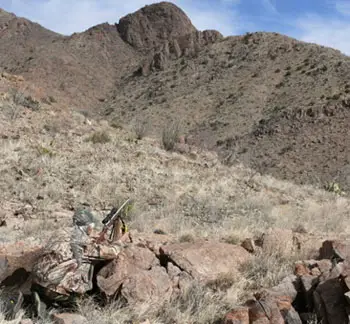|
In the Mountains with the Kestrel 4500 Weather Tracker
We reviewed the Kestrel 4500 in 2008 as a useful for target shooters and hunters, but had not had the opportunity to take it into the mountains ourselves. That changed in February 2010, when I traveled to the Floridas Mountains of New Mexico on the Mexican border to hunt for Persian Ibex. The Floridas are among the roughest mountains in the Rocky Mountain chain. They are simply large piles of disintegrating conglomerate rock, shale and cactus rising straight up from the desert�s floor. No gentle slopes to gradually work your way up; all access are by goat trails at incredible angles. The ibex is well suited to this terrain as their hooves have a soft inner area which is surrounded by the hard material of the outer hoof. In essence, they function like suction cups, allowing the critter to go anywhere they wish in the rocky terrain. Often, into areas that not even Spiderman could traverse. One of the guides remarked that Ibex are gyro-stabilized with flypaper feet, capable of walking on a six inch wide ledge at a 75 degree angle. Of course, humans are not. I recorded the winds, air temperature and barometric pressure several times each day during our hunt. Although the skies were clear and the winds were mild (0-5mph), conditions can change drastically in those mountains. For six days, the weather was perfect and the K4500 indicated no changes were coming. On the afternoon of the seventh day, the winds abruptly increased to 25 mph. We were so high up and precariously perched on the ledge of a cliff that I asked my guide to take the wind reading. (I don�t like the edges of cliffs when the winds are howling.) When he handed me the Kestrel back, I checked the barometric pressure and found it had dropped drastically in the past thirty minutes and so had the temperature (from 60 degrees down to 50). Although I am not a meteorologist, I surmised that with those two parameters tanking, a major weather front was about to move it. There was still some time for hunting left, so we stayed put, but I monitored the K4500 every half hour. Just before dark, I shot a nice Ibex with my Savage muzzle loader. After a brutal climb down to the Ibex, we began the process of dressing and caping. I checked the Kestrel again and the temperature was still dropping, from 50 degrees to 35 degrees, and the barometric pressure was even lower. I told my guide that we had better hurry up and get out of these mountains, NOW! We called in the other two guides to assist us in packing out the meat and headed down of the mountain. We arrived at our base camp at 9:00 PM, having hiked for three hours in the dark. By now, the winds had died down and everyone was wondering if the K4500 had given us a false alarm. We had our answer by the next morning. Clouds had rolled in overnight and snow covered the mountains. By mid-morning, the winds quickly reached 45 mph at our base camp, creating a sandstorm that made it impossible to see the base of the mountains and it was cold as hell. Bottom line, if we had been in those mountains when the storm hit, it would not have been good. It was obvious to everyone that the K4500 saved our party from a potentially disastrous situation. As I said in my original article, if you are going into the mountains, you should take a Kestrel. It is the cheapest insurance policy you can buy. |
